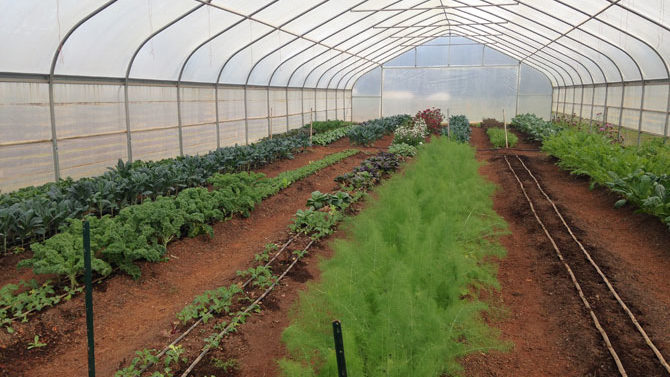The beginning of winter brings an end to the farmers market and CSA season. Though a determined Athenian can find local produce at a handful of spots in town, she can’t find the producers as easily. Like bears into hibernation, local farmers retreat to their farms to prepare for the next growing season. But for small farms like Front Field Farm, an Athens Farmers Market mainstay and Collective Harvest grower, there’s no time for long naps. They have a lot of work to do to prepare for spring.
“Really, it’s a lot of admin work that’s hard to get to when you’re growing,” says co-owner Jacqui Coburn. Her husband, Alex Rilko, points to the tractor that needs maintenance work and irrigation lines that need to be expanded and buried. That kind of thing gets harder when March rolls around.
Making her way toward the open fields beyond the barn, Coburn’s boots squish through the bright red clay that has almost spread to the barn door. All the recent rain, she says, washed out the gravel road. That will need to be repaired, too.
Tooner, the farm’s short-legged, yellow-haired mutt, bounds through a field of two-foot-high oat leaves, one of three cover crops Coburn planted to prep these beds for winter. Oat and vetch, Coburn explains, have a dense root system, which keeps the soil in place. Winter peas are a legume, which provide nitrogen to the soil. Come February, the cover crops will be bush-hogged and hoed into the soil, ready for planting. “I’m going to plant greens here,” says Coburn, “and root vegetables here.”
Coburn will work out a plan for just how much spring mix, kale, radishes or eggplant to plant—a framework for buying seeds, planting and harvest timelines and yield calculations for a whole year. Their decisions hinge on what they think Athens buyers want. “Carrots are good. Almost everyone likes carrots,” says Rilko. Lettuces and berries, he adds, are always on the list.
Coburn and Rilko will also work with the two other farms in Collective Harvest to predict growing needs. For example, if Collective Harvest decides to grow 500 pounds of beets, Coburn will bid to grow a percentage of the beets. “In the case of 20 percent, I’m responsible for 100 pounds of beets, so I’ll need to have them planted by a certain deadline so that they’re ready to harvest by April [when the spring CSA opens].”
In the midst of planning and repairs, many small farms are still yielding crops. Winter yields will vary from farm to farm depending on what resources it has available, says Coburn. A larger farm with a greenhouse can even continue growing summer crops through the winter.
“We have two hoophouses, so we have peppers growing next to carrots, in December,” says Coburn. A hoophouse is large, framed structure—Coburn’s measures 96 feet by 30 feet—made with plastic. Think of an unheated greenhouse. The plastic protects plants from wind, frost and the dropping winter temperatures. (Coburn throws some credit for her peppers to the persistent warmth in December.)
Walking into the hoophouse, the bite of 40-degree morning air is gone. The temperature inside is even a little balmy. “A little sheet of plastic makes a big difference,” says Coburn. They plan to install another hoophouse once the ground dries enough to start building.
For the rest of winter, Coburn and Rilko are relying on the smaller cousin to the hoophouse called a “caterpillar” to protect individual beds of winter crops. So named for its segmented appearance, a caterpillar is a rounded plastic tent that stretches along the length of one bed. “These were an experiment for us this year,” says Coburn, “but they seem to be working out.”
With the help of a little plastic, Front Field is producing root veggies, plenty of kale and greens, enough that Coburn continues to make about two deliveries a week to the Daily Groceries Co-op and local restaurants.
At the end of the month, Coburn, like many other small farm owners, will head to growers conferences where they can exchange ideas, share successes and discuss the year ahead. “I have a stack of seed catalogues this high,” says Coburn, holding her hands a foot apart. “I get sucked in!” But she admits she’ll have to decide what to order soon. Very soon: She has to start planting trays by the end of the month. In a few months, those trays will have been planted, harvested and sold for Athens’ eating pleasure.
Like what you just read? Support Flagpole by making a donation today. Every dollar you give helps fund our ongoing mission to provide Athens with quality, independent journalism.










